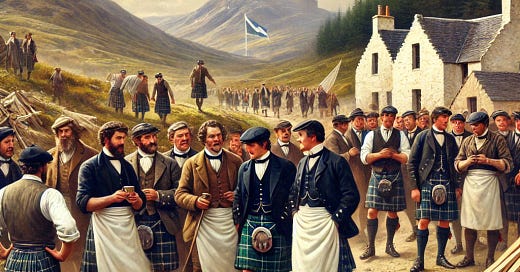How Wrights' Walk Became the Highland Games
The Braemar Highland Games, known worldwide for its display of traditional Scottish sports and vibrant cultural festivities, has a fascinating origin story that begins with a simple yet significant event: the Wrights' Walk. This early 19th-century gathering, initially involving a small group of tradesmen, laid the foundation for what would become one of Scotland's most celebrated cultural traditions. But how did a humble walk among local carpenters evolve into the grand spectacle of athleticism and heritage we see today? Let's delve into this captivating transformation.
The Beginnings: A Simple Walk
The story of the Wrights' Walk begins in July 1800 in the picturesque village of Braemar, nestled in the Scottish Highlands. The "Wrights," or carpenters, were a vital part of the local community, known for their craftsmanship and camaraderie. This walk was not just a casual stroll but a purposeful gathering of men like Duncan Watson, Duncan Mackintosh, Malcolm McGregor, William Gruer, and Angus Macdonald. It was a chance to come together, share stories, and engage in friendly competition.
The early Wrights' Walk involved these tradesmen traversing the scenic paths around Braemar. The community spirit was evident as they donned their white aprons and walked together, a symbol of unity and pride in their craft. This modest gathering soon became a regular event, drawing more participants and spectators each year, intrigued by the spectacle of skilled workers engaging in what was becoming a local tradition.
The Evolution into Games
As the Wrights' Walk grew in popularity, it began to evolve beyond its initial scope. What started as a social event for a few craftsmen quickly became a more organized and formalized occasion. The camaraderie and competitive spirit of the walk inspired the addition of various physical challenges. Competitions in running, jumping, and strength tests soon became part of the event, transforming it into a more dynamic gathering.
By the early 19th century, the Wrights' Walk had begun to resemble what we recognize today as the Highland Games. It was no longer just a walk—it had become a showcase of skill, strength, and endurance, set against the stunning backdrop of the Scottish Highlands. The evolution was spurred on by the natural athleticism and competitive nature of the participants, who were eager to prove their prowess not just in their trade but also in physical feats.
Formalization and Royal Endorsement
The turning point in the history of the Wrights' Walk came with the formal recognition of the event as a structured competition. The gathering began to attract attention from beyond the local community, drawing participants from surrounding areas and even further afield. By 1824, the event had grown significantly, with formal rules and the introduction of prize money for winners.
The games received a royal endorsement in the mid-19th century when Queen Victoria, enamored with the Scottish Highlands and its traditions, began to take an interest in the Braemar Gathering. Her patronage brought national attention to the event, solidifying its status as a key cultural fixture. This royal recognition marked the official transformation of the Wrights' Walk into what is now known as the Braemar Highland Games, celebrated by locals and visitors alike.
The Highland Games Today: A Legacy of the Wrights' Walk
Today, the Braemar Highland Games are an internationally renowned event, drawing spectators and participants from around the world. They feature traditional Scottish athletic contests such as the caber toss, tug-of-war, and stone putting, alongside dancing, piping, and other cultural displays. The games remain a vibrant celebration of Scottish heritage, deeply rooted in the community spirit and friendly competition that characterized the original Wrights' Walk.
The legacy of the Wrights' Walk lives on in every aspect of the Highland Games. From the sense of community to the spirit of competition, the event remains true to its origins as a gathering of neighbors and friends celebrating their shared culture and skills. The transformation from a simple walk among craftsmen to a globally recognized cultural celebration is a testament to the enduring power of community, tradition, and the human spirit.
Conclusion
The story of how the Wrights' Walk became the Highland Games is a remarkable journey of evolution and tradition. What began as a modest gathering of carpenters in a small Highland village has grown into a world-famous event that continues to honor the skills, strength, and spirit of its participants. As the Highland Games continue to thrive, they serve as a vibrant reminder of the rich cultural heritage of Scotland and the power of community to create lasting traditions.





